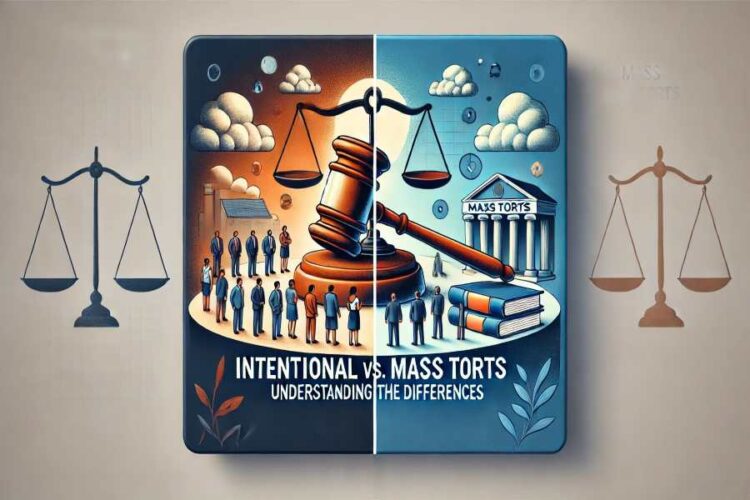In personal injury law, torts are wrongful acts that cause harm or injury to another person, leading to legal liability. Torts can be broadly categorized into intentional torts and mass torts, each with unique characteristics, legal processes, and implications. This article explores the key differences between intentional torts and mass torts, providing a comprehensive understanding of these concepts and their significance in the realm of personal injury law.
1. Defining Intentional Torts
Intentional torts occur when an individual deliberately engages in conduct that results in harm to another person. The hallmark of an intentional tort is the intent behind the action, not necessarily the intent to cause harm, but the intent to perform the act that led to the injury.
- Examples of Intentional Torts:
- Assault: Creating a reasonable apprehension of imminent harmful or offensive contact.Battery: Unlawful physical contact with another person without their consent.False Imprisonment: Unlawfully restricting a person’s freedom of movement.Intentional Infliction of Emotional Distress (IIED): Extreme and outrageous conduct causing severe emotional distress.Trespass to Land: Unauthorized entry onto another person’s property.
- Conversion: Wrongfully taking or controlling another person’s property.
2. Defining Mass Torts
Mass torts, on the other hand, involve large numbers of plaintiffs against one or a few defendants. These cases arise from widespread harm caused by defective products, hazardous materials, environmental disasters, or other large-scale events. Unlike intentional torts, mass torts typically involve negligence or strict liability rather than intentional wrongdoing.
- Examples of Mass Torts:
- Defective Products: Harm caused by products with design, manufacturing, or labeling defects (e.g., pharmaceutical drugs, medical devices, consumer products).
- Environmental Disasters: Large-scale exposure to toxic substances or pollutants (e.g., oil spills, chemical leaks).
- Public Health Crises: Widespread harm from public health issues (e.g., asbestos exposure, contaminated water supplies).
3. Legal Elements and Burden of Proof
The legal elements and burden of proof differ significantly between intentional torts and mass torts.
- Intentional Torts:
- Intent: The plaintiff must prove that the defendant intended the act that caused the harm.
- Act: There must be a volitional act by the defendant.
- Causation: The defendant’s intentional act must directly cause the plaintiff’s injury.
- Injury: The plaintiff must show actual harm or injury resulting from the defendant’s act.
- Mass Torts:
- Negligence or Strict Liability: Plaintiffs typically need to prove that the defendant was negligent or that strict liability applies.
- Causation: Plaintiffs must demonstrate that the defendant’s conduct caused their injuries.
- Injury: There must be actual harm or injury suffered by the plaintiffs.
- Commonality: Plaintiffs must show that their injuries arise from a common cause or event.
4. Legal Proceedings and Case Management
The legal proceedings and case management for intentional torts and mass torts also vary significantly.
- Intentional Torts:
- Individual Lawsuits: Intentional tort cases are usually filed as individual lawsuits, with one plaintiff suing one defendant.
- Discovery Process: The discovery process involves exchanging evidence between the parties, including witness statements, medical records, and other relevant documents.
- Trial: If the case goes to trial, the plaintiff must prove their case by a preponderance of the evidence.
- Mass Torts:
- Consolidated Cases: Mass torts often involve consolidating multiple cases into a single legal action to streamline the process and manage the large volume of claims.
- Multidistrict Litigation (MDL): In the federal court system, mass tort cases may be transferred to a single district court for pretrial proceedings under the MDL process.
- Class Action Lawsuits: In some cases, mass torts may be pursued as class action lawsuits, where a representative plaintiff files on behalf of a larger group of affected individuals.
- Settlement Negotiations: Due to the large number of plaintiffs, mass tort cases often involve complex settlement negotiations and compensation distribution plans.
5. Damages and Compensation
The types of damages and compensation available in intentional tort and mass tort cases can differ.
- Intentional Torts:
- Compensatory Damages: Intended to compensate the plaintiff for actual losses, including medical expenses, lost wages, pain and suffering, and emotional distress.
- Punitive Damages: In cases of particularly egregious conduct, punitive damages may be awarded to punish the defendant and deter similar behavior in the future.
- Mass Torts:
- Compensatory Damages: Similar to intentional torts, compensatory damages cover medical expenses, lost wages, and other actual losses.
- Punitive Damages: While less common in mass torts, punitive damages may be awarded in cases involving gross negligence or willful misconduct.
- Settlement Funds: Mass tort cases often result in the establishment of settlement funds to distribute compensation among the plaintiffs.
6. Legal Representation and Support
Both intentional tort and mass tort cases require specialized legal representation and support.
- Intentional Torts:
- Personal Injury Attorneys: Plaintiffs typically seek representation from Seattle attorneys with experience in handling car accident cases, which can classify as an intentional tort.
- Expert Witnesses: Expert witnesses may be called to testify on the nature and extent of the injuries, as well as the defendant’s conduct.
- Mass Torts:
- Mass Tort Attorneys: Plaintiffs in mass tort cases often work with law firms that specialize in mass tort litigation and have the resources to handle large-scale cases.
- Legal Teams: Due to the complexity of mass tort cases, legal teams may include multiple attorneys, paralegals, and support staff.
- Coordination with Other Plaintiffs: Mass tort attorneys often coordinate with other plaintiffs’ attorneys to share information and strategies.
7. Challenges and Considerations
Both intentional tort and mass tort cases present unique challenges and considerations for plaintiffs.
- Intentional Torts:
- Proving Intent: Demonstrating the defendant’s intent can be challenging and often requires substantial evidence.
- Defendant’s Defense: Defendants may raise various defenses, such as consent, self-defense, or privilege, to avoid liability.
- Mass Torts:
- Commonality of Claims: Establishing the commonality of claims among a large number of plaintiffs can be complex.
- Settlement Distribution: Ensuring fair distribution of settlement funds among plaintiffs requires careful planning and administration.
- Protracted Litigation: Mass tort cases can take years to resolve, requiring patience and persistence from plaintiffs.
8. Conclusion
Intentional torts and mass torts represent distinct areas of personal injury law, each with its own legal processes, challenges, and implications. Intentional torts involve deliberate actions that cause harm, requiring proof of intent and offering the possibility of punitive damages. Mass torts involve large-scale harm affecting numerous plaintiffs, often resulting from negligence or strict liability, and typically involve complex legal proceedings and settlements.
Understanding these key differences is essential for individuals seeking to pursue claims in these areas and for legal professionals navigating the intricacies of personal injury law. By recognizing the unique aspects of intentional and mass torts, plaintiffs can better protect their rights and seek appropriate compensation for their injuries.










